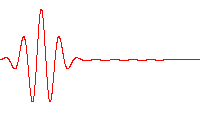 | ||
In solid-state physics crystal momentum or quasimomentum is a momentum-like vector associated with electrons in a crystal lattice. It is defined by the associated wave vectors
Contents
- Lattice symmetry origins
- Physical significance
- Relation to velocity
- Response to electric and magnetic fields
- ARPES
- References
(where
Lattice symmetry origins
A common method of modeling crystal structure and behavior is to view electrons as quantum mechanical particles traveling through a fixed infinite periodic potential
where
These conditions imply Bloch's theorem, which states in terms of equations that
or in terms of words that an electron in a lattice, which can be modeled as a single particle wave function
One of the notable aspects of Bloch's theorem is that it shows directly that steady state solutions may be identified with a wave vector
While this is in fact identical to the definition one might give for regular momentum (for example, by treating the effects of the translation operator by the effects of a particle in free space), there are important theoretical differences. For example, while regular momentum is completely conserved, crystal momentum is only conserved to within a lattice vector, i.e., an electron can be described not only by the wave vector
where
Physical significance
The phase modulation of the Bloch state
In regions where the band is approximately parabolic the crystal momentum is equal to the momentum of a free particle with momentum
Relation to velocity
Crystal momentum corresponds to the physically measurable concept of velocity according to
This is the same formula as the group velocity of a wave. More specifically, due to the Heisenberg uncertainty principle, an electron in a crystal cannot have both an exactly-defined k and an exact position in the crystal. It can, however, form a wave packet centered on momentum k (with slight uncertainty), and centered on a certain position (with slight uncertainty). The center position of this wave packet changes as the wave propagates, moving through the crystal at the velocity v given by the formula above. In a real crystal, an electron moves in this way—traveling in a certain direction at a certain speed—for only a short period of time, before colliding with an imperfection in the crystal that causes it to move in a different, random direction. These collisions, called electron scattering, are most commonly caused by crystallographic defects, the crystal surface, and random thermal vibrations of the atoms in the crystal (phonons).
Response to electric and magnetic fields
Crystal momentum also plays a seminal role in the Semiclassical model of electron dynamics, where it obeys the equations of motion (in cgs units):
Here perhaps the analogy between crystal momentum and true momentum is at its most powerful, for these are precisely the equations that a free space electron obeys in the absence of any crystal structure. Crystal momentum also earns its chance to shine in these types of calculations, for, in order to calculate an electron's trajectory of motion using the above equations one need only consider external fields, while attempting the calculation from a set of EOMs based on true momentum would require taking into account individual coulomb and Lorenz forces of every single lattice ion in addition to the external field.
ARPES
In angle-resolved photo-emission spectroscopy (ARPES), irradiating light on a crystal sample results in the ejection of an electron away from the crystal. Throughout the course of the interaction, one is allowed to conflate the two concepts of crystal and true momentum and thereby gain direct knowledge of a crystal's band structure. That is to say, an electron's crystal momentum inside the crystal becomes its true momentum after it leaves, and the true momentum may be subsequently inferred from the equation
by measuring the angle and kinetic energy at which the electron exits the crystal (
